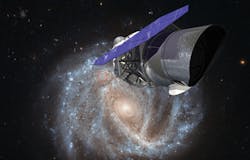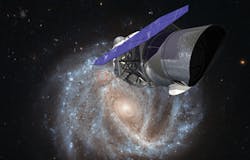NASA scientists choose Harris Precision Optics to build WFIRST space optical imaging telescope
U.S. space scientists needed a precision optical instrument to be the core imager of the nation’s next-generation orbiting deep-space observation system. They found their solution from the Harris Corp. Precision Optics segment in Rochester, N.Y.
Officials of the National Aeronautics and Space Administration (NASA) Goddard Space Flight Center in Greenbelt, Md., in December announced a $195.9 million eight-year contract to Harris Precision Optics to design and build the optical telescope assembly (OTA) for the future Wide Field Infrared Survey Telescope (WFIRST).
The future WFIRST orbiting space-observation instrument will have nearly 300 times as many pixels as the infrared camera of the Hubble Space Telescope, and will be able to take images with 100 times the field of view of Hubble. Also working on this contract is the Harris Space and Intelligence Systems segment in Palm Bay, Fla.
This large field of view will enable WFIRST to survey large areas of the sky to measure the effects of dark matter and dark energy on the distribution of galaxies in the universe.
The Harris Precision Optics optical telescope assembly for the WFIRST spacecraft will include the inherited primary and secondary mirrors with precision metering structures that are to be integrated to new mirror assemblies to provide optical feeds to the WFIRST instruments.
Harris will provide the personnel, services, materials, equipment, and facilities to build, refurbish, or modify the WFIRST optical telescope, as well as fabricate align, test, verify, and deliver the telescope to NASA Goddard Space Flight Center.
Harris also will handle post-delivery support for the observatory integration and test program, as well as for on-orbit observatory checkout and commissioning.
WFIRST will be a NASA observatory to perform wide-field imaging and surveys of the near infrared sky. WFIRST will be six-year mission, and is scheduled for launch in 2025 to orbit at the Sun-Earth L2 point.
WFIRST to study the newly discovered phenomenon of dark energy, measuring the history of cosmic acceleration, completing the exoplanet census begun by NASA’s Kepler Space Telescope and demonstrating technology for direct imaging and characterization of exoplanets.
The U.S. National Research Council has rated WFIRST as one of NASA’s top-priority large-scale missions. Last May WFIRST entered its preliminary design phase to begin major procurements for flight hardware.
In addition to the optical telescope assembly, the WFIRST space observatory will have a wide-field instrument with two channels: a combination of wide-field imaging and spectrographic channels called the wide field channel; and a narrow-field spectrographic channel — the integral field channel.
The two channels, with their optics and science data electronics are to be in an on-orbit replaceable cold-sensing module beneath the WFIRST optical telescope assembly.
On this contract Harris Optical Systems and Space and Intelligence Systems will do the work in Rochester, N.Y., Palm Bay, Fla., and at Goddard Space Flight Center, Md., and should be finished by December 2025. For more information contact Harris Precision Optics online at www.harris.com/solution/precision-optics,Harris Space and Intelligence Systems at www.harris.com/sis, or NASA Goddard Space Flight Center at www.nasa.gov/goddard.

